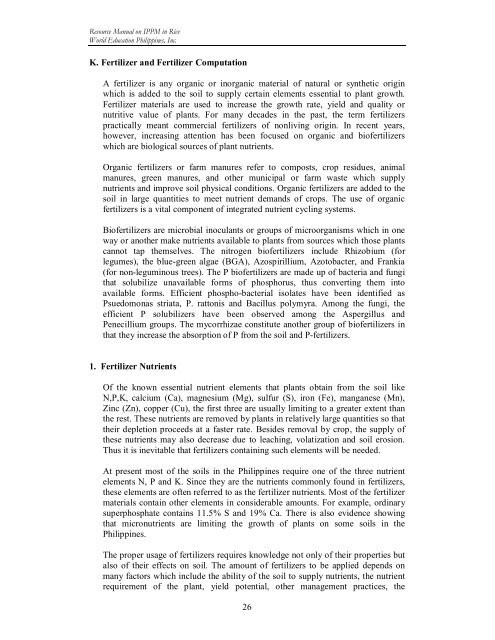(IPPM) in Vegetables - Vegetableipmasia.org
(IPPM) in Vegetables - Vegetableipmasia.org
(IPPM) in Vegetables - Vegetableipmasia.org
Create successful ePaper yourself
Turn your PDF publications into a flip-book with our unique Google optimized e-Paper software.
Resource Manual on <strong>IPPM</strong> <strong>in</strong> Rice<br />
World Education Philipp<strong>in</strong>es, Inc.<br />
K. Fertilizer and Fertilizer Computation<br />
A fertilizer is any <strong>org</strong>anic or <strong>in</strong><strong>org</strong>anic material of natural or synthetic orig<strong>in</strong><br />
which is added to the soil to supply certa<strong>in</strong> elements essential to plant growth.<br />
Fertilizer materials are used to <strong>in</strong>crease the growth rate, yield and quality or<br />
nutritive value of plants. For many decades <strong>in</strong> the past, the term fertilizers<br />
practically meant commercial fertilizers of nonliv<strong>in</strong>g orig<strong>in</strong>. In recent years,<br />
however, <strong>in</strong>creas<strong>in</strong>g attention has been focused on <strong>org</strong>anic and biofertilizers<br />
which are biological sources of plant nutrients.<br />
Organic fertilizers or farm manures refer to composts, crop residues, animal<br />
manures, green manures, and other municipal or farm waste which supply<br />
nutrients and improve soil physical conditions. Organic fertilizers are added to the<br />
soil <strong>in</strong> large quantities to meet nutrient demands of crops. The use of <strong>org</strong>anic<br />
fertilizers is a vital component of <strong>in</strong>tegrated nutrient cycl<strong>in</strong>g systems.<br />
Biofertilizers are microbial <strong>in</strong>oculants or groups of micro<strong>org</strong>anisms which <strong>in</strong> one<br />
way or another make nutrients available to plants from sources which those plants<br />
cannot tap themselves. The nitrogen biofertilizers <strong>in</strong>clude Rhizobium (for<br />
legumes), the blue-green algae (BGA), Azospirillium, Azotobacter, and Frankia<br />
(for non-legum<strong>in</strong>ous trees). The P biofertilizers are made up of bacteria and fungi<br />
that solubilize unavailable forms of phosphorus, thus convert<strong>in</strong>g them <strong>in</strong>to<br />
available forms. Efficient phospho-bacterial isolates have been identified as<br />
Psuedomonas striata, P. rattonis and Bacillus polymyra. Among the fungi, the<br />
efficient P solubilizers have been observed among the Aspergillus and<br />
Penecillium groups. The mycorrhizae constitute another group of biofertilizers <strong>in</strong><br />
that they <strong>in</strong>crease the absorption of P from the soil and P-fertilizers.<br />
1. Fertilizer Nutrients<br />
Of the known essential nutrient elements that plants obta<strong>in</strong> from the soil like<br />
N,P,K, calcium (Ca), magnesium (Mg), sulfur (S), iron (Fe), manganese (Mn),<br />
Z<strong>in</strong>c (Zn), copper (Cu), the first three are usually limit<strong>in</strong>g to a greater extent than<br />
the rest. These nutrients are removed by plants <strong>in</strong> relatively large quantities so that<br />
their depletion proceeds at a faster rate. Besides removal by crop, the supply of<br />
these nutrients may also decrease due to leach<strong>in</strong>g, volatization and soil erosion.<br />
Thus it is <strong>in</strong>evitable that fertilizers conta<strong>in</strong><strong>in</strong>g such elements will be needed.<br />
At present most of the soils <strong>in</strong> the Philipp<strong>in</strong>es require one of the three nutrient<br />
elements N, P and K. S<strong>in</strong>ce they are the nutrients commonly found <strong>in</strong> fertilizers,<br />
these elements are often referred to as the fertilizer nutrients. Most of the fertilizer<br />
materials conta<strong>in</strong> other elements <strong>in</strong> considerable amounts. For example, ord<strong>in</strong>ary<br />
superphosphate conta<strong>in</strong>s 11.5% S and 19% Ca. There is also evidence show<strong>in</strong>g<br />
that micronutrients are limit<strong>in</strong>g the growth of plants on some soils <strong>in</strong> the<br />
Philipp<strong>in</strong>es.<br />
The proper usage of fertilizers requires knowledge not only of their properties but<br />
also of their effects on soil. The amount of fertilizers to be applied depends on<br />
many factors which <strong>in</strong>clude the ability of the soil to supply nutrients, the nutrient<br />
requirement of the plant, yield potential, other management practices, the<br />
26




![Section 4 [ PDF file, 252 KB] - The Field Alliance](https://img.yumpu.com/51387260/1/158x260/section-4-pdf-file-252-kb-the-field-alliance.jpg?quality=85)












